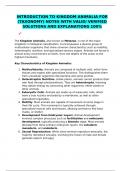INTRODUCTION TO KINGDOM ANIMALIA FOR
(TAXONOMY) NOTES WITH VALID/ VERIFIED
SOLUTIONS AND EXPLANATIONS 100%
The Kingdom Animalia, also known as Metazoa, is one of the major
kingdoms in biological classification. It encompasses a diverse group of
multicellular organisms that share common characteristics such as mobility,
heterotrophic nutrition, and specialized sensory organs. Animals are found in
almost every environment on Earth, from the depths of the ocean to the
highest mountains.
Key Characteristics of Kingdom Animalia:
1. Multicellularity: Animals are composed of multiple cells, which form
tissues and organs with specialized functions. This distinguishes them
from unicellular organisms like bacteria and some protists.
2. Heterotrophic Nutrition: Unlike plants, animals cannot produce their
own food through photosynthesis. They are heterotrophs, meaning
they obtain energy by consuming other organisms, either plants or
other animals.
3. Eukaryotic Cells: Animals are made up of eukaryotic cells, which
have a true nucleus enclosed by a membrane, as well as other
specialized organelles.
4. Motility: Most animals are capable of movement at some stage in
their life cycle. This movement is typically achieved through
specialized muscle cells and tissues, allowing animals to find food,
mates, or shelter.
5. Development from Embryonic Layers: Animal development
involves complex processes such as fertilization and embryonic
development, typically producing a blastula stage. Most animals
develop from three primary embryonic layers: the ectoderm,
mesoderm, and endoderm.
6. Sexual Reproduction: While some animals reproduce asexually, the
majority reproduce sexually, involving the fusion of male and female
gametes (sperm and egg).
, 7. Lack of Cell Walls: Animal cells are not enclosed by rigid cell walls
like those of plants and fungi. Instead, they have a flexible plasma
membrane.
Classification within Kingdom Animalia:
Animals are broadly classified into two groups:
1. Invertebrates: These animals lack a backbone or vertebral column.
Examples include insects, mollusks, arachnids, and sponges.
Invertebrates account for more than 95% of all known animal species.
2. Vertebrates: These animals have a backbone or vertebral column and
belong to the subphylum Vertebrata. Examples include fish,
amphibians, reptiles, birds, and mammals.
Major Phyla of Kingdom Animalia:
1. Porifera (Sponges): Simple animals that lack tissues and organs,
with bodies full of pores and channels.
2. Cnidaria: Includes jellyfish, corals, and sea anemones, known for their
stinging cells.
3. Platyhelminthes: Flatworms, including tapeworms and flukes, with
simple body structures.
4. Annelida: Segmented worms like earthworms and leeches.
5. Mollusca: Includes snails, clams, and octopuses, known for their soft
bodies and, in many cases, a hard shell.
6. Arthropoda: The largest phylum, including insects, spiders, and
crustaceans, characterized by segmented bodies and exoskeletons.
7. Chordata: This includes vertebrates such as mammals, birds, and fish,
and is defined by the presence of a notochord at some stage of
development.
Animals are sorted out based on some key basic traits such as how their cells
are arranged, the symmetry of their bodies, and if they have a coelom or
not.
Cellular level of organization: This is the simplest level, where cells
are loosely put together, seen in creatures like sponges.




